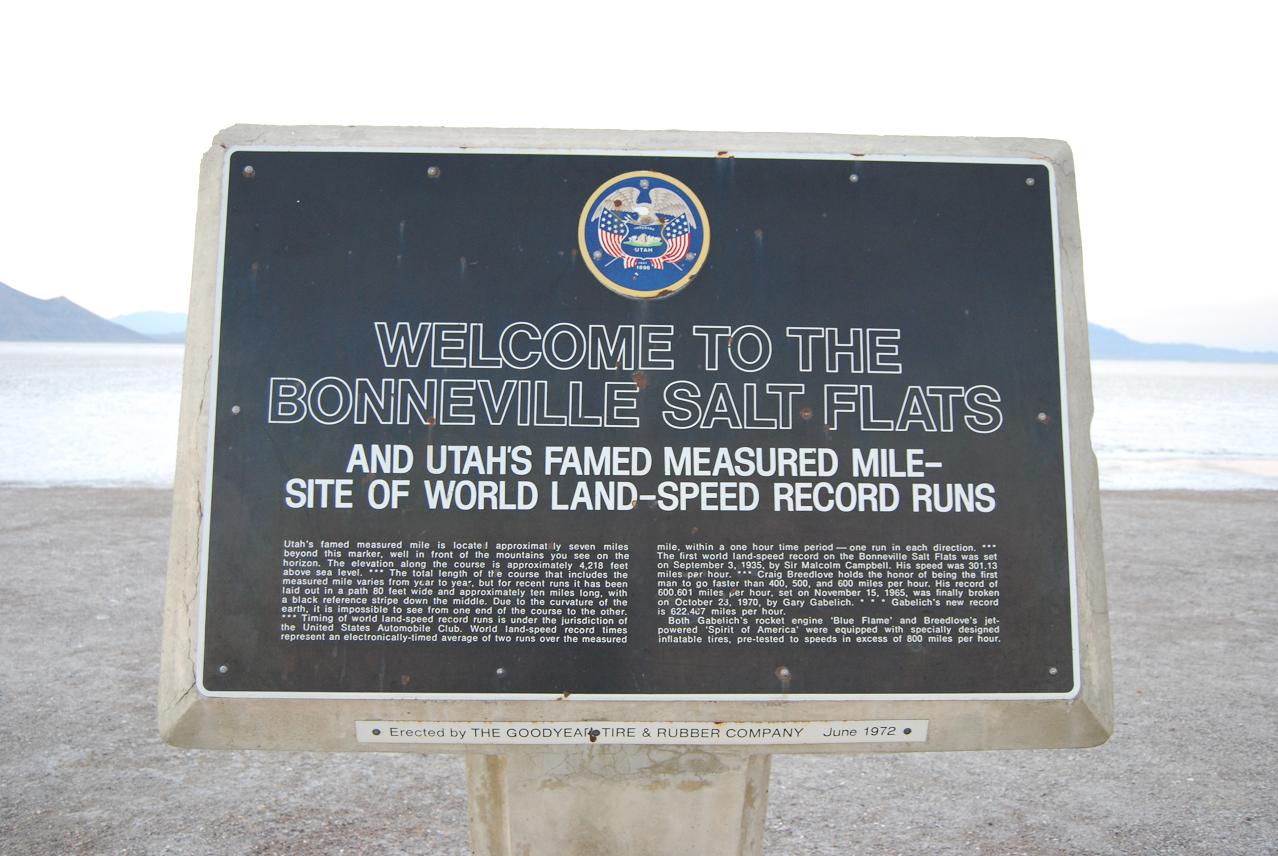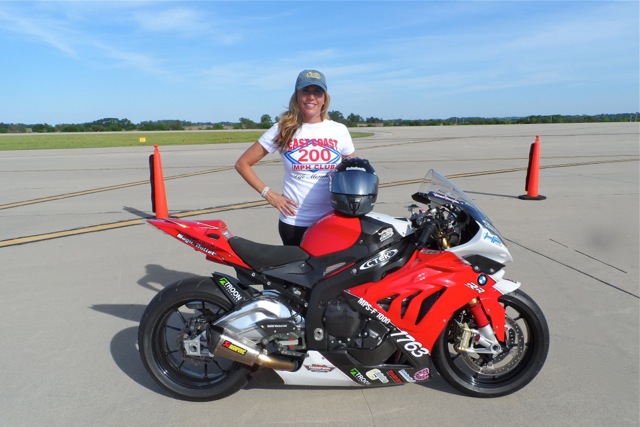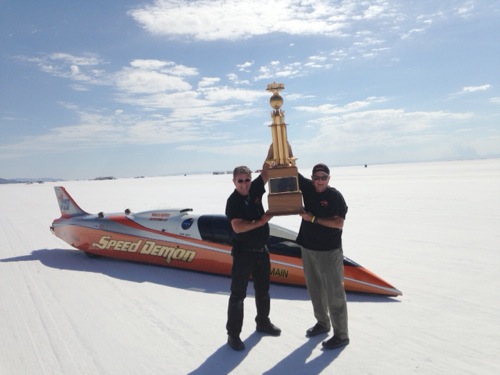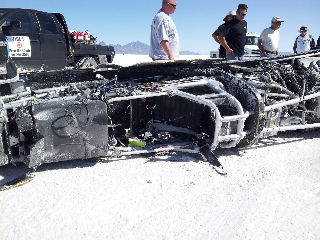Bonneville 2014 Was Full of False Starts and New Records
By noderel:
noderel:
profilepic:


Photos: John Gunnell, Valerie Thompson, Speed Demon
Every enthusiast knows the Bonneville Salt Flats is a unique place. If you approach from Salt Lake City, you come to a rest stop on I-80 where you can see the terrain and read plaques telling its history. The plaque starts off: “Utah’s famed measured mile is located approximately seven miles beyond this marker, well in front of the mountains you see on the horizon.” It says the speedway is at 4,218 ft. and that in recent years the course is about 80 ft. wide and 10 miles long. Bonneville racing began as early as 1914. The first official measured mile run was on Sept. 3, 1935 by Sir Malcolm Campbell. He went 301.13 mph.

Originally the speedway was marked out by the Utah Department of Transportation and the Salt Lake City Chamber of Commerce. At some point the Bureau of Land Management (BLM) stepped in and let contracts to prepare the courses. In the mid ‘70s Utah Salt Flats Racing Assoc. and Strasburg's won the bid and prepared the courses for a few years. BLM stopped paying and course preparation fell back onto the hosting organization. About 20 years ago The Southern California Timing Association (SCTA) and Bonneville Nationals, Inc. (BNI) and USFRA started charging a course prep fee to the competitors. The money is deposited in a shared account and course prep is paid for from that.
Before World War II there was the 10-mile long straightway for speed trials and an oval track for distance runs. Since the 1990s, event organizers have prepared tracks in the most ideal area they can fiind. A black line or lines was used until 2009 and then replaced by track markers such as flags or cones. 2013 was the first year that the USFRA started using a line made with a water-based dye. It is similar to the red and blue you see at skiing events. The number of tracks and the timed sections for each track are up to the event organizers.

There are four main events at Bonneville Speedway each year, plus private meets. In August, the SCTA and (BNI) put on Speed Week, which began in 1949. It is the largest meet of the year. Another August event is the Bonneville Motorcycle Speed Trials (Formerly BUB). In September the USFRA, based in Salt Lake City, conducts the “World of Speed.” This venue started back in 1986. In October, the SCTA and BNI returns to the salt for the World Finals.
This year was unusual. Speed Week—scheduled for Aug. 9-15, 2014 and promoted as the 100th Anniversary of Salt Flats Racing—was cancelled due to weather conditions. The official announcement said “The SCTA Board is currently on the salt, and has determined that the standing water will not dry in time for us to hold our annual Speed Week event. The Board is also discussing the possibility of extending our next event World Finals (Sept. 30–Oct 3) into a full week of racing as a sort of delayed Speed Week. We thank you all for your patience and understanding. We look forward to seeing you at our next event.”

This didn’t mean no records were set by racers who came for Speed Week. The debut of Ohio State’s Venturi Buckeye Bullet 3 was set for Speed Week. Despite its cancellation, the VBB-3 team remained on site for a private event and scored an FIA (not SCTA-BNI) record with professional driver Roger Schroer. While additional rain and high winds during the private event prevented VBB-3 from making as many runs as planned, the team prevailed. Due to the rains. the course was cut from the typical 6-1/2 miles to less than 3-1/2 miles. The VBB-3 recorded an average 2-way speed of 212.615 miles per hour to set the new record in Category A Group VIII Class 8. It also had a 1-way speed of 270 mph.
The 2014 Bonneville Motorcycle Speed Trials Aug, 23-28 struggled, but got in a few days of runs. Despite monsoon rains, nearly 1,000 successful runs were made. Records were set by entries from small vintage bikes to a KillaJoule electric streamliner raced by Eva Hakansson and her team that ent over 241 mph. It was a year of adaptation and overcoming long odds to make a successful race week. “This wouldn’t have happened without the riders, the sponsors and the collaboration of all of the salt flats race organizations,” said the promoters.
The World of Speed on Sept. 6-9 was the only totally successful event of 2014 “We had a very good meet,” USFRA Secretary Ellen Wilkinson told Hot Rod Hotline. “Basically we pulled it off, along with a July test and tune off.”
The July Test-N-Tune was successful with excellent weather and a quality prepared racing course. Approximately 50 racers used this rare opportunity in July to prepare newly constructed vehicles for upcoming competitive events. The Test-N-Tune event was such a winner that the USFRA plans a repeat of the event next year. The second USFRA Test-N-Tune is set for July 8-13, 2015.

Valerie Thompson and her BMW successfully made it into the 200 mph club.
The USFRA’s World of Speed event went on in spite of August rains that left the salt damp in spots. There were 280 entries in various classes. The crowd size and number of participants made it the largest-ever USFRA event. There were 50 SCTA Competition Class records set. Allen Levie, Steve Nelson and Valarie Thompson got in the 200-mph Club. Thompson set a new 1000-MPS-G.
The 130-mph Club gained 21 racers who achieved a two run average over 130 mph in street legal vehicles and 14 additional racers earned membership in the 150-mph Club. The VW Challenge had excellent participation and speeds as high as Gabe Adams 187.077 mph. The VW Challenge group has grown to be one of the largest and most interesting groups at World of Speed each year. The Fast Pass of the meet was Danny Thompson’s 424.858-mph run. Jim Higgens set the Fast Bike of the Meet mark with a 228.587 mph performance. Tannis Hammond was the Fast Lady of the Meet at 320.839 mph.

On Sept. 12, George Poteet’s Speed Demon streamliner showed up at what was supposed to be Mike Cook's Bonneville Shootout, typically a private event for the fastest cars and bikes.

This year it was changed to a test and tune session with no official times due to standing water at the end of the long course and surface issues near the beginning. Cook fell back to a 5- or 6-mile approach to a 132-ft. trap as it was too wet to do much else. The Speed Demon got a little sideways at nearly 370 mph and rolled several times. Poteet walked away from the car and was taken by ambulance to Salt Lake City for observation. Everyone who participated in designing, fabricating and maintaining the car over the years can be proud of the fact that George walked away with only bumps and bruises.
The last event—promoted as “Speed Week” at the World Finals—was set for Sept. 27-Oct. 3, but ran into the same problem as August Speed Weeks. At 7:30 pm Sunday the following message came out: “It's raining now. Speed Week at World Finals on the famous Bonneville Salt Flats has been cancelled. The Advanced Crew of SCTA President Scott Andrews and Race Director Bill Lattin reviewed the BSF race courses and determined they are too wet to have any reasonable expectation of being dry enough to provide a quality race course.”
